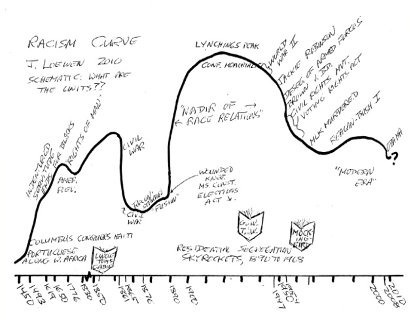What follows is not a very competent graph. Note that there is no scale on the left, no vertical axis units! On the other hand, it is the best graph Loewen ever saw of the amount of racism in U.S. culture over time … because it’s the only one! All the rest of this website has information about each of these eras. Readers can come to their own conclusions as to what caused racism to go down in some periods (1862 – 1875, for example) and go up in others (1890 – 1940). Especially important is the Nadir of race relations, 1890-1942. — Art Fleming invented a trivia game based on Loewen’s research about the Nadir. He did a great job. Play it here!

This racism curve can be seen in many ways:
- For example, students can examine the treatment of John Brown in old U.S. history textbooks published during and right after Reconstruction (roughly 1866 – 1890), the Nadir (1890 – 1940), the “long” Civil Rights period (1940 – c.1976), and the recent past (1976 – 2020). They will see that after about 1890 he grows crazier; after 1940 he gets somewhat saner.
- Or, with help from Chapter 11 of Social Science in the Courtroom, they can compare “D,” the Index of Dissimilarity for residential segregation for a nearby city, over time.
- They can compare stories about Black people in their local newspaper, over time. Leola Bergmann did this in Iowa. (See “The Negro in Iowa,” in Iowa Journal of History and Politics, 1948.)
- They can learn about race relations in their favorite sport, whether baseball, horse racing, boxing, the NFL, college basketball, the NBA, even cycling. Typically African Americans could participate until sometime after 1890, and then were again allowed after about 1946. Golf and NASCAR took longer.
Best-selling novels show the racism curve
The three best-selling novels in U.S. history were all written by white women, and all treat race relations in the South as a central theme. Each was dominant in its century. Together they show the impact of their position on the Racism Curve.
- Uncle Tom’s Cabin was certainly the most important novel of the nineteenth century. Written in 1852, it sold a huge number of copies in newspaper form and then in book form. Then it was made into dramas for the stage and performed more than 10,000 times. It shows slavery more or less accurately; as a result, it had an abolitionist impact. Its central character, Uncle Tom, was not an uncle Tom.
- Gone With the Wind was the dominant novel of the twentieth century. In constant dollars it brought in more money than any other movie, as well. Its position on slavery? Margaret Mitchell mourned the end of the old plantation life as “gone with the wind.” Written in about 1936, it deepened the Nadir of race relations by causing readers and viewers to have sympathy for the slave system, portraying African Americans as “creatures of small intelligence,” to quote the author.
- To Kill a Mockingbird became the most popular novel of the first quarter of the current century. Written in 1960, in the midst of the Civil Rights Movement, it is not as deeply racist as Gone With the Wind, but rather is an example of the “White Redeemer” tale: Atticus Finch, the lawyer, is the white savior who saves the day … except, the day does not get saved! The key Black character goes to jail and there gets killed. But this does not seem to matter, because he is only a minor person in the book and film.